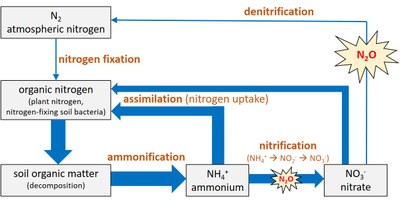N2O emissions as response of process-related soil microbial activity to different irrigation and nitrogen fertilization regimes in potato cropping
This DFG funded project is a cooperation between the Leibniz Institute for Agricultural Engineering and Bioeconomy (ATB) in Potsdam and the Ecology Group of the Humboldt-Universität zu Berlin.
Nitrous oxide (N2O) is known for increasing the greenhouse effect - with a higher warming potential than carbon dioxide (CO2). N2O is released by the process of nitrification and in particular during denitrification. Thereby, the size of N2O emission due to the activity of soil microbial populations is influenced by water supply and fertilization.

The aim of the project is to investigate the influence of different irrigation-fertilization regimes on the N2O production in a potato cropping system, focussing on the microbial-mediated processes and the groups linked with N2O emission.
We use molecular and biochemical methods to analyse the microbial communities, for instance phospholipid fatty acids (PLFAs) as chemotaxonomic markers to estimate microbial biomass and community structure. Additionally, soil nematodes are counted and identified to family level. The nematode faunal analysis concept, based on functional guilds, is used to assign soil conditions and health. Nematode indices (e.g. Enrichment Index, Structure Index) will determine the impact of the different management regimes on the soil micro-food web. Furthermore, simultaneous to each soil sampling the gas emission in defined closed chambers are captured. After analysing the gas samples by using a gaschromatograph the N2O fluxes are calculated. Additionally, soil physical and chemical parameters and the phenological stage of crops are assessed.